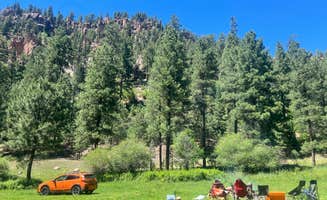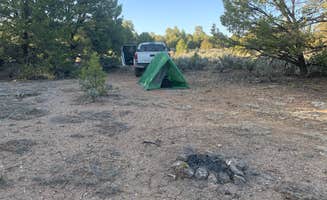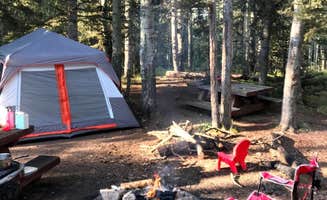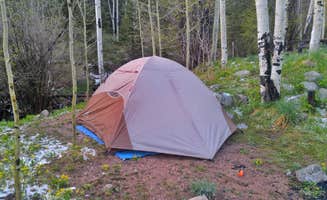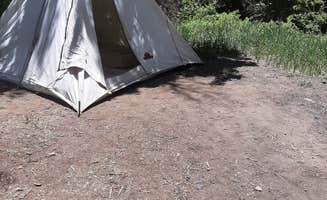Tent camping near Cañones, New Mexico offers primitive wilderness experiences with dramatic seasonal temperature variations. Most dispersed sites sit between 7,500-9,000 feet elevation within the Carson and Santa Fe National Forests, where summer thunderstorms frequently occur between July and September. Campgrounds in this region feature distinct high desert pine and juniper ecosystems with limited shade at many locations.
What to do
Wildlife viewing opportunities: At American Springs, campers regularly spot large mammals in the meadows below campgrounds. "Elk grazing below were the cherry on top," reports Matthew N., who enjoyed watching wildlife from his campsite overlooking the canyon.
Trout fishing access: Multiple fishing spots available within 30-45 minute drives from most campsites. "It has three lakes filled with trout. Lots of areas to explore," notes Ricky B. about Canjilon Creek Campground, where anglers can fish at 9,000 feet elevation in relative solitude.
Stream exploration: Several campgrounds feature small creeks ideal for cooling off during hot summer days. At Big Tesuque Campground, Bailey B. noted, "I loved it because it was next to a little river and the sites are so spaced out!" The shallow streams provide natural play areas for children.
Hiking from camp: Many sites connect directly to trail systems without requiring additional driving. "Hiking trails from the campground," mentions Rhonda D. about Resumidero Camping Area, making it convenient for morning walks without packing up gear.
What campers like
Temperature relief: The high elevation camping provides escape from summer heat in nearby urban areas. Campsites at 8,000+ feet can be 10-15 degrees cooler than Albuquerque or Santa Fe. "Very quiet and peaceful. It does get cold at night since at approximately 8,000 elevation," notes Maeci W. from her experience at Road 378 near Fenton Lake.
Site spacing: Many campgrounds offer substantial distance between sites for privacy. "The camp sites were far apart and you could chose between open meadows or in the trees," reports Rhonda D. about her experience at Resumidero Camping Area.
Dark sky stargazing: Minimal light pollution allows exceptional night sky viewing. "It snowed heavily, but that only added to the beauty!" shares Brett B. about winter camping at Big Tesuque Campground, where clear nights offer spectacular stellar views due to high elevation and distance from cities.
Stream sounds: Several campers appreciate the natural white noise provided by creeks. "Nice babbling brook alongside campsites, fun for kids to play in (COLD, but shallow), and makes for great white noise," reports C.J. L. about the camping experience at Big Tesuque Campground.
What you should know
Vehicle requirements: Many sites require significant clearance or 4WD capability. "Probably not a must have, but I highly recommend a four-wheel-drive high clearance to get back into the camp spots here," advises Mark about American Springs, where road conditions can deteriorate rapidly after rain.
Seasonal preparation: Weather varies dramatically by season and can change quickly. "It got cold at night, like 27°F," reports Jacob W. about his spring camping at Carson NF Forest Service Road 578, indicating the need for proper cold-weather gear even in warmer months.
Water access limitations: Most sites require bringing all water needs or filtering from streams. No potable water exists at most dispersed sites, requiring 1-2 gallons per person per day minimum.
Human waste concerns: Some sites show evidence of improper waste disposal. "The poop that littered this campsite made this site basically uninhabitable," warns Nora S. about Road 378 near Fenton Lake, highlighting the importance of proper sanitation practices.
Tips for camping with families
Stream play areas: Shallow creeks provide natural entertainment for children. "The Rio grande was cold but worth the swim," shares Tyler R. about Taos Junction Campground, located approximately 40 miles north of Cañones with family-friendly water access.
Wildlife viewing preparation: Bring binoculars for wildlife spotting from safe distances. "I saw two elk across a swath of sage," reports Jacob W. about his camping experience at Carson NF Forest Service Road 578.
Site selection strategy: For families with young children, select sites closest to parking areas. "Essential hike in, uphill, have to carry your gear. The further in your campsite, the more hiking you will do," advises C.J. L. about Big Tesuque Campground, suggesting families choose sites nearest to parking.
Temperature planning: Pack layers even in summer, as nighttime temperatures drop significantly. "Chilly, even in July, just FYI, come prepared," warns C.J. L. about the temperature fluctuations at Big Tesuque Campground.
Tips from RVers
Clearance considerations: Standard RVs cannot access most dispersed sites in this area. "RVs will not make it, so it's nice and quiet. AWD/4WD needed on the rutted rocky road," explains Kala J. about camping at Carson NF Forest Service Road 578.
Limited amenities warning: No hookups or dump stations exist at most National Forest sites. "Not much in the area available for hook up rv sites. We decided to boondock here for the night with a generator for AC," shares Samantha L. about her experience at Cuba Highway pulloff on Forest Road 88.
Washout risk: Roads can become quickly impassable after rainfall. "The road is quite rocky and there's a large washout just past the first site," notes Matthew N. about American Springs, emphasizing the importance of checking recent weather conditions.


